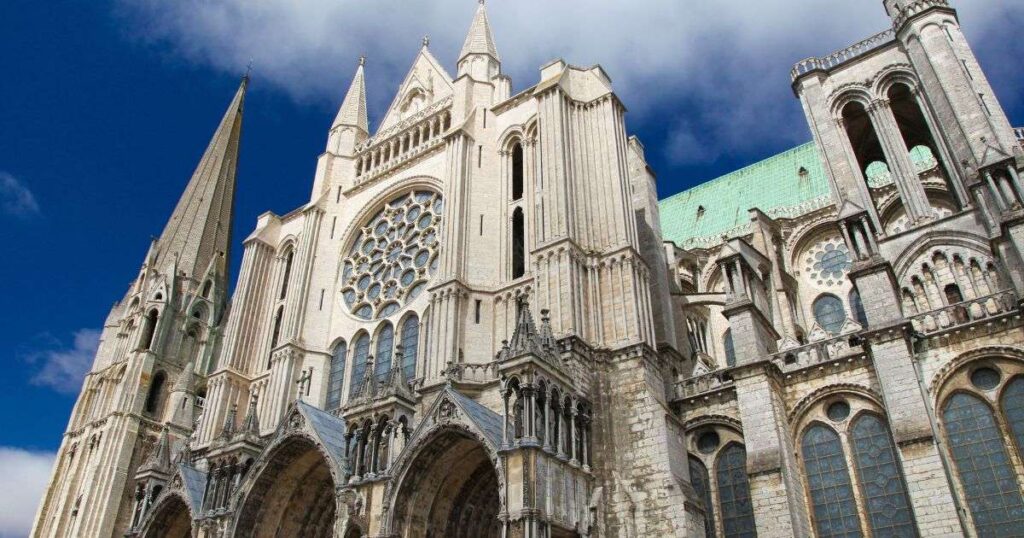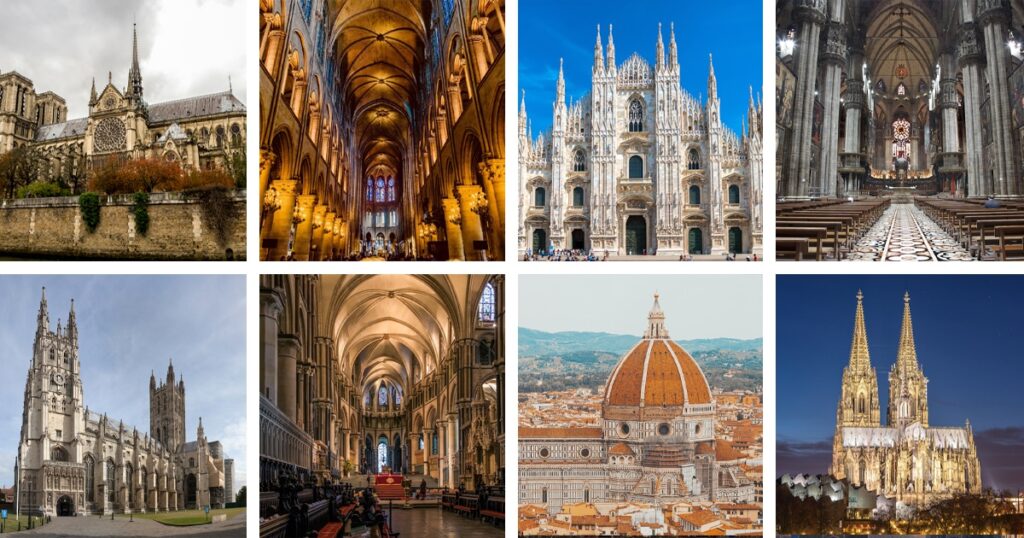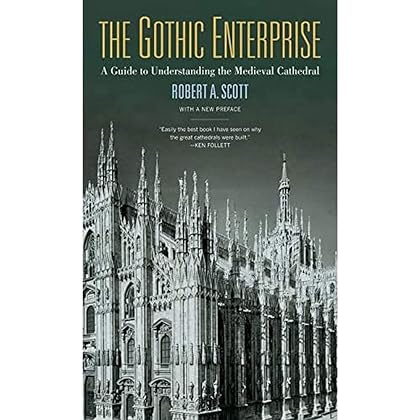France is renowned for its captivating architecture, a seamless blend of ancient Gothic cathedrals and modern marvels that stand as a testament to the country’s rich history and innovative spirit. From the awe-inspiring beauty of Notre-Dame de Paris to the iconic elegance of the Eiffel Tower, every corner of France boasts architectural wonders that have captured the imagination of people worldwide. Whether you are an avid history enthusiast or simply appreciate the splendor of grand structures, exploring the architecture of France is an experience that will leave you in awe.
1. Gothic Architecture
1.1 Origins and Characteristics
Gothic architecture originated in France in the 12th century and quickly spread across Europe. One of the defining characteristics of Gothic architecture is its emphasis on verticality. Gothic cathedrals are known for their soaring height, pointed arches, ribbed vaults, and flying buttresses. These architectural elements allowed for larger and more open spaces inside the cathedrals, creating a sense of grandeur and spirituality. The stained glass windows, another hallmark of Gothic architecture, filled the cathedrals with an ethereal light, adding to the mystical atmosphere.
1.2 Famous Gothic Cathedrals
France is home to many famous Gothic cathedrals, each with its own unique architectural features and historical significance. The Notre-Dame Cathedral in Paris is perhaps the most famous example of Gothic architecture in the world. Its iconic flying buttresses and intricately designed façade make it a true masterpiece. Other notable Gothic cathedrals in France include Chartres Cathedral, Reims Cathedral, and Amiens Cathedral. These cathedrals not only served as places of worship but also as symbols of power and prestige during medieval times.
1.3 Notable Features of Gothic Cathedrals
Gothic cathedrals are known for their distinctive architectural features. The pointed arches, a characteristic of Gothic architecture, allowed for taller and more spacious interiors compared to the rounded arches of Romanesque architecture. Ribbed vaults, another key feature, distributed the weight of the ceiling more efficiently, allowing for thinner walls and larger windows. The flying buttresses were external supports that helped counterbalance the outward thrust of the vaults, allowing for even greater height and larger stained glass windows. These elements combined to create a visually stunning and structurally impressive style of architecture.
2. Renaissance Architecture
2.1 Introduction to Renaissance Architecture
Renaissance architecture emerged in Italy in the 15th century and later spread to other parts of Europe, including France. This architectural style was heavily influenced by the revival of classical Greek and Roman architecture and emphasized proportion, symmetry, and the use of classical orders such as Doric, Ionic, and Corinthian. Renaissance architects sought to create harmonious and balanced buildings that reflected the ideals of the Renaissance period, which celebrated humanism and the importance of the individual.
2.2 Influences and Key Features
Renaissance architecture in France was influenced by Italian architectural styles, particularly the works of renowned architects such as Andrea Palladio and Filippo Brunelleschi. One of the key features of Renaissance architecture is the use of classical elements such as columns, pilasters, and pediments. Buildings were often designed with a central axis and symmetrical facades. The use of domes, inspired by Roman architecture, became popular during this period. The Château de Chambord, with its prominent central dome and symmetrical layout, is a prime example of Renaissance architecture in France.
2.3 Prominent Examples of Renaissance Architecture
France is home to several prominent examples of Renaissance architecture. The Château de Fontainebleau, located near Paris, is a masterpiece of Renaissance design. Its symmetrical façade, elegant courtyards, and decorative details showcase the beauty and grandeur of this architectural style. The Château de Chenonceau, known as the “Ladies’ Castle,” is another notable example. Its elegant arches, delicate ornaments, and picturesque setting make it a beloved attraction. These architectural treasures not only reflect the artistic and cultural achievements of the Renaissance period but also offer a glimpse into the lives of the French nobility.

3. Baroque Architecture
3.1 The Emergence of Baroque Style
Baroque architecture originated in Italy in the late 16th century and spread across Europe throughout the 17th and 18th centuries. In France, the Baroque style gained prominence during the reign of Louis XIV, also known as the Sun King. Baroque architecture is characterized by its ornate and extravagant style, designed to impress and awe viewers. It is known for its dramatic forms, intricate detailing, and lavish decoration.
3.2 Key Elements of Baroque Architecture
Baroque architecture in France often featured opulent interiors, grand facades, and elaborate ornamentation. Buildings were designed to create a sense of theatricality, with curved facades, domes, and sweeping staircases. The Palace of Versailles, a prime example of French Baroque architecture, showcases these elements on a grand scale. Its intricate stonework, gilded decorations, and extensive use of mirrors create a breathtaking visual experience. The Chapel of the Palace of Versailles, with its grand dome and ornate interior, exemplifies the beauty and grandeur of the Baroque style.
3.3 Noteworthy Baroque Structures in France
In addition to the Palace of Versailles, France is home to several other noteworthy Baroque structures. The Church of Saint-Sulpice in Paris is a stunning example of Baroque architecture, with its imposing facade and impressive interior. The Hôtel de Ville in Lyon, with its ornate balcony and detailed sculptures, is another standout example. The Château de Vaux-le-Vicomte, known for its exquisite gardens and lavish interiors, is a testament to the opulence and elegance of French Baroque architecture. These structures continue to inspire awe and admiration for their architectural beauty.
4. Neoclassical Architecture
4.1 Neoclassical Movement in France
Neoclassical architecture emerged in the late 18th century as a reaction against the ornate and extravagant style of the Baroque and Rococo periods. Inspired by the classical architecture of ancient Greece and Rome, neoclassical architects sought to create buildings that embodied simplicity, balance, and rationality. In France, the neoclassical movement gained popularity during the Enlightenment, a time when reason and logic were highly valued.
4.2 Characteristics of Neoclassical Architecture
Neoclassical architecture is characterized by its clean lines, symmetrical façades, and classical elements such as columns and pediments. Buildings were designed to evoke a sense of harmony and order, with an emphasis on proportion and balance. The Louvre Museum in Paris, originally a palace and later transformed into a museum, is a prime example of neoclassical architecture in France. Its elegant colonnades, balanced composition, and geometric forms reflect the principles of the neoclassical style.
4.3 Iconic Neoclassical Buildings in France
France is home to several iconic neoclassical buildings that showcase the beauty and elegance of this architectural style. The Arc de Triomphe, located in Paris, is one such structure. Its monumental arch, adorned with intricate reliefs, pays homage to the military victories of Napoleon Bonaparte. The Panthéon, originally built as a church but later repurposed as a mausoleum, is another notable example of neoclassical design. Its imposing dome, surrounded by a colonnade, is a striking sight. These architectural gems continue to captivate visitors with their timeless beauty.

5. Beaux-Arts Architecture
5.1 Introduction to the Beaux-Arts Style
Beaux-Arts architecture emerged in France in the 19th century and became popular during the Belle Époque, a period of artistic and cultural flourishing. It was characterized by its grandeur, attention to detail, and emphasis on classical architectural elements. Beaux-Arts architects drew inspiration from various architectural styles, incorporating elements of Renaissance, Baroque, and neoclassical design. The style was often associated with prestigious public buildings, such as museums, government offices, and train stations.
5.2 Influence and Characteristics
The Beaux-Arts style had a significant influence on the architecture of the late 19th and early 20th centuries, not only in France but also in other parts of the world. It emphasized the use of noble materials, such as marble and stone, and featured elaborate decorations, sculptures, and ornamental details. Buildings were designed to evoke a sense of monumentality and grandeur, with symmetrical facades and a hierarchical arrangement of spaces. The Opéra Garnier in Paris, with its opulent interiors, grand staircase, and ornate façade, is a prime example of Beaux-Arts architecture.
5.3 Significant Beaux-Arts Buildings
France boasts several significant Beaux-Arts buildings that continue to impress with their architectural splendor. The Palais Garnier, also known as the Opéra Garnier, is one of the most famous examples. Its lavish interiors, adorned with marble, gold leaf, and chandeliers, reflect the Beaux-Arts style at its pinnacle. The Gare de Lyon, a train station in Paris, is another notable example. Its magnificent clocktower, intricate ironwork, and grand entrance hall make it a masterpiece of Beaux-Arts architecture. These buildings serve as enduring symbols of the Belle Époque and showcase the elegance and craftsmanship of the Beaux-Arts style.
6. Art Nouveau Architecture
6.1 Origins and Features of Art Nouveau
Art Nouveau was an architectural and artistic movement that emerged in the late 19th century and lasted until the early 20th century. It was characterized by its organic forms, flowing lines, and the incorporation of natural motifs. Art Nouveau architects sought to break away from traditional architectural styles and create a new aesthetic that reflected the spirit of the age. This style embraced the use of innovative materials and techniques, such as curved ironwork, stained glass, and mosaic.
6.2 Notable Art Nouveau Structures in France
France is known for its many remarkable examples of Art Nouveau architecture. The Paris Métro entrances, designed by Hector Guimard, are one of the most recognizable features of the city. These intricately designed ironwork entrances, with their sinuous lines and floral motifs, epitomize the Art Nouveau style. The Casa Batlló in Barcelona, designed by Antoni Gaudí, is another notable example of Art Nouveau architecture. Its undulating façade, colorful mosaic, and imaginative forms make it a true masterpiece of the style. These structures continue to inspire with their innovative designs and artistic flair.
6.3 Influences and Legacy of Art Nouveau
Art Nouveau was influenced by various artistic and cultural movements, including the Arts and Crafts movement and the Symbolist movement. It sought to combine art and architecture in a harmonious and holistic way. While the Art Nouveau movement was relatively short-lived, its influence can still be seen in contemporary design. Its emphasis on organic forms, decorative motifs, and innovative materials laid the foundation for later architectural styles, such as Art Deco and organic architecture. The legacy of Art Nouveau lives on in the works of architects and designers who continue to be inspired by its artistic vision.

7. Modernist Architecture
7.1 Modernism in French Architecture
Modernism emerged as a response to the rapid social and technological changes of the late 19th and early 20th centuries. It was characterized by its emphasis on simplicity, functionality, and a rejection of ornamentation. Modernist architects sought to create buildings that reflected the needs of the modern age, with an emphasis on efficiency, rationality, and the use of new materials and construction techniques. In France, modernist architecture gained prominence during the early 20th century, particularly after World War I.
7.2 Key Principles and Innovations
Modernist architecture in France embraced the principles of functionalism and the idea that form should follow function. Buildings were designed to serve their purpose efficiently and respond to the needs of their occupants. Open floor plans, large windows, and the incorporation of new materials such as steel, glass, and concrete were common features of modernist architecture. The Unité d’Habitation in Marseille, designed by Le Corbusier, is a renowned example of modernist design. Its modular design, innovative use of concrete, and incorporation of communal spaces revolutionized the concept of housing.
7.3 Iconic Modernist Buildings in France
France is home to several iconic modernist buildings that continue to inspire with their innovative designs. The Villa Savoye, also designed by Le Corbusier, is one such building. Its stark white façade, ribbon windows, and rooftop garden showcase the principles of modernist architecture. The Centre Georges Pompidou in Paris, designed by Renzo Piano and Richard Rogers, is another notable example. Its exposed structural elements, colorful exterior, and flexible interior spaces make it a symbol of modernity. These buildings challenged traditional notions of architecture and offered a new vision for the future.
8. Postmodern Architecture
8.1 Postmodernist Movement in France
Postmodern architecture emerged in the late 20th century as a reaction against the perceived coldness and impersonality of modernist architecture. It sought to reintroduce ornamentation, historical references, and a sense of playfulness into architectural design. In France, postmodernist architecture gained popularity during the 1980s and 1990s, particularly in commercial and institutional buildings.
8.2 Characteristics and Influences
Postmodern architecture is characterized by its eclectic style, combining elements from various architectural traditions and time periods. It often incorporates historical references, such as classical motifs, decorative elements, and pastiche. Postmodern architects believed that buildings should respond to their cultural and historical context, and they sought to create designs that were visually engaging and memorable. The Pyramid of the Louvre, designed by I.M. Pei, is a prominent example of postmodern architecture in France. Its modern glass pyramid, surrounded by classical structures, reflects a harmonious blend of old and new.
8.3 Noteworthy Postmodern Buildings
France is home to several noteworthy postmodern buildings that capture the spirit of the movement. La Grande Arche de la Défense, located in the business district of Paris, is an iconic postmodern structure. Its monumental arch shape, glass facade, and bold geometric forms make it a striking sight. The Place de la Musique et de la Danse in Strasbourg, designed by Christian de Portzamparc, is another standout example. Its colorful façade, undulating forms, and playfulness reflect the spirit of postmodernism. These buildings challenge conventional notions of architectural style and celebrate the diversity of design.

9. Contemporary French Architecture
9.1 Exploring the Current Architectural Landscape
Contemporary French architecture continues to evolve and embrace new technologies, materials, and design philosophies. Architects today are challenged to create sustainable, innovative, and people-centric designs that respond to the needs of a rapidly changing world. Contemporary architecture in France encompasses a wide range of styles, from minimalist designs to experimental forms.
9.2 Sustainable and Eco-Friendly Approaches
One of the key focuses of contemporary French architecture is sustainability and eco-friendliness. Architects are incorporating sustainable design principles, such as energy-efficient materials, renewable energy systems, and green spaces, into their projects. The Cité du Design in Saint-Étienne, designed by LIN Architects, is a prime example of sustainable architecture. Its green roof, use of recycled materials, and emphasis on natural light showcase a sustainable and eco-friendly approach to design.
9.3 Examples of Innovative Contemporary Designs
France is home to several innovative contemporary architectural designs that push the boundaries of creativity and functionality. The Musée du Quai Branly-Jacques Chirac in Paris, designed by Jean Nouvel, is known for its organic forms, lush green walls, and integration with the surrounding landscape. The Fondation Louis Vuitton, designed by Frank Gehry, is another architectural marvel. Its sail-like glass panels, distinctive form, and use of cutting-edge construction techniques make it a testament to innovation in design. These buildings represent the forefront of contemporary architecture and continue to inspire with their bold and imaginative designs.
10. Architectural Gems of France
10.1 Exploring Iconic French Landmarks
France is home to a wealth of iconic landmarks and architectural wonders that attract millions of visitors each year. From the ancient Roman amphitheater in Arles to the modernist masterpiece of the Villa Savoye, every corner of France offers architectural gems waiting to be discovered. The Eiffel Tower in Paris, a symbol of the city and a feat of engineering, remains one of the most visited landmarks in the world. The Mont Saint-Michel, a medieval abbey perched on a rocky island, is another architectural marvel that captivates with its dramatic setting. Exploring these iconic landmarks allows you to witness the rich architectural heritage of France.
10.2 UNESCO World Heritage Sites
France is home to numerous UNESCO World Heritage Sites that showcase the country’s architectural and cultural significance. The Palace of Versailles, with its opulent interiors and elaborate gardens, is recognized as an outstanding example of Baroque architecture. The Historic Centre of Avignon, with its well-preserved medieval walls and the Papal Palace, offers a glimpse into the city’s historical importance. The Historic Fortified City of Carcassonne, with its impressive fortifications, is another UNESCO site that showcases France’s rich architectural past. These sites provide a window into the cultural and historical legacy of France.
10.3 Modern Architectural Marvels
France is also home to modern architectural marvels that reflect the country’s innovative and forward-thinking approach to design. The Millau Viaduct, designed by architect Norman Foster, is the world’s tallest cable-stayed bridge and a testament to engineering prowess. The Musée du Quai Branly-Jacques Chirac, with its striking green walls and interactive exhibits, presents a contemporary approach to museum design. The Lyon-Saint Exupéry Airport, designed by Santiago Calatrava, showcases a fusion of architecture and transportation, with its sweeping roof and sleek design. These modern architectural marvels demonstrate France’s commitment to pushing the boundaries of design and engineering.
In conclusion, France’s architectural journey has been a captivating tale of changing styles, cultural influences, and artistic expressions. From the soaring Gothic cathedrals to the innovative designs of contemporary architecture, France’s architectural heritage is a treasure trove waiting to be explored. Whether you are wandering through the halls of the Louvre or marveling at the grandeur of the Palace of Versailles, each architectural gem offers a glimpse into the rich history and artistic achievements of France. So, take a moment to immerse yourself in the beauty and wonder of French architecture and discover the fascinating stories behind each architectural masterpiece.

